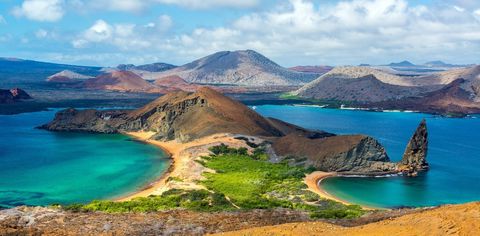The erosion of soil and rock is a natural process that occurs on Earth’s surface. Erosion removes and transports soil, sand and other materials from one location and deposits them in another.
To reduce erosion, plant vegetation that provides roots and cover to protect the soil from rainfall and wind. Plants also add nutrients to the soil and increase its strength.
Soil Erosion
Soil erosion happens when bare soil is exposed to intense winds, hard rains, and flowing water. It is especially pronounced on sloped terrain. Erosion accelerates when the land is less vegetated, as is the case with deserts and many cultivated areas where crops are grown year round.
Tilling (plowing) and overgrazing farm animals also leave soils devoid of ground-covering plants that slow water flows and protect the soil. The resulting soils are more susceptible to erosion by wind and water, as well as more quickly degraded by climate change.
Unmitigated soil erosion decreases the quality of soil ecosystems and reduces the amount of arable land that can be used to grow food crops. It is a global problem that has contributed to hunger and is a major contributor to climate change.
It contributes to pollution and sedimentation in rivers, streams, and lakes that can reduce fish populations. It also makes floods worse. It also lowers the ability of soils to absorb carbon dioxide, which increases the overall level of greenhouse gases in the atmosphere. It is a huge global challenge that can only be addressed through better and more sustainable land management practices. It takes time to rebuild and restore eroded soils, but it is possible.
Water Erosion
Water erosion is the displacement of soil particles by water, which can be caused by rainfall, melted snow, flowing rivers, or the freeze/thaw cycles. It plays a major role in the loss of topsoil—the vital layer that holds the majority of a soil’s nutrients and microorganisms.
Water can erode land in a variety of ways, including stream bank erosion and gully erosion. Stream bank erosion occurs when a river eats away at its banks over time, creating a V-shaped valley. Gullies form when water erodes the sides and bottom of a depression on a slope, eventually filling it with debris that is then carried downstream. The Fish River Canyon in Namibia is an example of valley erosion that took millions of years to occur.
Erosion is accelerated by many natural factors, but human activity can also make it happen more quickly. For example, when trees are cut down for agriculture or development and their roots wash away, the land becomes more vulnerable to erosion. Similarly, plowing up grasses and using fertilizers can also contribute to soil degradation.
Some places are more prone to erosion than others, depending on the type of terrain, climate, and vegetation. Regions with sloping landscapes are usually more affected by erosion than flat areas. And, rocks that are soft or made of a material that dissolves easily in water wear down more slowly than hard, resistant materials.
Wind Erosion
Wind erosion is one of the most serious natural processes affecting drylands. Wind erosion destroys soil by blowing it away and carrying it to new locations.
This process also can damage surrounding vegetation and exposes the surface of rocks to weathering. Wind erosion can also carry pollutants into the air, such as sand and dust. It also carries disease-causing organisms, such as those that cause alfalfa leaf spot and common blight of beans.
Aeolian erosion can create amazing landforms and create a variety of different environmental conditions. It can create desert dunes that rise to more than 100 meters (3,300 feet). It also erodes and polishes the rock layers of the Badain Jaran section of the Gobi Desert in China, giving them the appearance of a “desert varnish.” Wind erosion is responsible for the eroded shapes that give Arches National Park in Utah its name. It’s also responsible for the eroded sandstone arches that make up the Twelve Apostles Marine National Park in Australia.
The most important factor in wind erosion is soil type and climatic conditions. The more sandy the soil, the more vulnerable it is to wind erosion. A study by Savic [10] investigated the vulnerability of a part of AP Vojvodina to eolian erosion and found that the region was highly sensitive. This vulnerability is exacerbated by the fact that overgrazing, a common practice in agriculture, further increases erosion rates.
Ice Erosion
Glacier erosion sculpts the landscape, forming unique shapes such as fjords and U-shaped valleys. These eroded features provide valuable clues about the Earth’s past climate conditions and can help us understand how to prepare for and adapt to climate change today.
Physical erosion is often slowed by the presence of plants. Roots of these plants stick to soil and rock particles, preventing them from being carried away by rain or wind. The friction between rocks as they collide also causes erosion, as does the action of glacial ice against bedrock. The resulting process, called bioerosion, can produce cracks and crevices in the surface of the rocks.
Glacial erosion, on the other hand, can be very rapid and is largely caused by the motion of the glacier itself. Two important processes of glacial erosion are plucking and abrasion. The motion of the glacier against the rocks of a mountain can cause them to be worn away, and these eroded bits are then spat out into the meltwater streams that form glaciers.
The rapid erosion of mountains and coastlines by melting glaciers can create massive debris flows, known as mass wasting events. This can cause landslides and other disasters that may threaten lives and property. A better understanding of the relationship between geological hazards and climatic changes is essential to developing effective mitigation and adaptation strategies.

